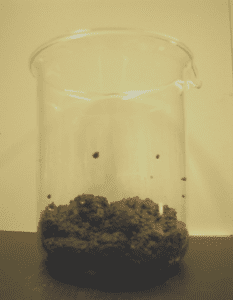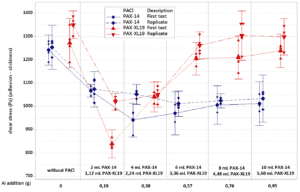Polyaluminum chloride (PACl) is used as a conditioning agent for reducing the stickiness of waste-activated sludge in wastewater-treatment applications. Presented here is a study comparing two PACl species with different degrees of polymerization
The sticky behavior of waste-activated sludge (WAS) during mechanical dewatering and thermal drying is an important practical challenge in sludge handling installations in the chemical process industry (CPI) as discussed in two earlier articles published in Chemical Engineering by this lead author [1, 2]. Those articles discussed a practical way to cope with the sticky phase of sludge – adding PAX-14, a commercially available polyaluminum chloride (PACl), to the sludge. This article presents a short comparative study between PAX-14 and PAX-XL19 as conditioners for WAS to reduce its sticky character.
Increasing volumes of excess activated sludge
The generation of WAS is increasing due to higher levels of urbanization and more stringent environmental legislation for the discharge of treated wastewater. According to a study prepared for the European Commission, the sludge production in the EU27 (including 27 member states in the European Union since 2008) was 11.5 million tons DS (dry substance) in 2010, and this will rise to 13 million tons DS by 2020 [3]. In China, more than 40 million tons DS of dewatered sludge are annually produced [4].
Since biological sludge is removed from wastewater treatment plants in a very dilute form containing only 1–2% DS, dewatering and drying operations constitute essential unit operations at wastewater treatment plants to reduce the sludge volume (and cost) for further downstream handling [5]. One of the fundamental aspects of the application of sludge dewatering and drying is the sludge’s sticky phase. Handling the sticky phase stands as a truly practical challenge in the daily operation of sludge dewatering-drying units [6].
Changing sludge texture
The texture of activated sludge changes substantially when its water content is lowered. The dewatering sludge consecutively goes through three phases: wet, sticky and granular. When sludge reaches the DS range where it behaves most sticky — known as the sticky phase [7] — the sludge then has a high affinity to stick to the surface of the drying equipment. The sticky characteristics of partially dewatered sludge are in essence caused by the presence of extracellular polymeric substances (EPS) excreted by the microorganisms. When the EPS become more concentrated during the dewatering/drying process, they behave increasingly as a glue, transforming the sludge into a sticky material that impedes the ongoing volume-reduction process. While EPS play a key role in the sticky phase of sludge [1], filaments also impact the sticky phase [2], and it is expected that there are other factors that contribute to this complex rheological behavior of sludge.
There has been an increasing interest in sludge conditioners to reduce the sludge’s stickiness in recent years. Researchers have been investigating the effect of sludge conditioning with CaO [4, 8-10], flyash and wood fines [9, 11] and PACl (more specifically PAX-14 [12]).
A giant aluminum polycation
PACls are widely known as chemicals added to wastewater to remove colloidal material from wastewater in flotation-unit operations. Another application of PAX-14 lies in the control of bulking and foaming problems due to Microthrix parvicella [13]. Moreover, the addition of PAX-14 to WAS has a positive impact on the sludge drying rate. This benefit complements the stickiness-mitigating effect of PAX-14 [14].
A special feature of the inorganic aluminum polymers is the formation of highly charged polycations [AlO4Al12(OH)24(H2O)12]7+, also referred to as Al13 polymers, when added to water [15]. For a 3D-model of this fascinating superstructure, the reader is referred to the September 2016 issue of Chem. Eng. [2]. A series of PACls is commercially available, including PAX-14 and PAX-XL19 (the latter is characterized by a higher degree of polymerization). In the context of a higher degree of polymerization, other polycation species are formed by further polymerization, such as [(AlO4)2Al28(OH)56(H2O)26]18+ which is composed of two Al13 polymers and four Al monomers. These are identified as Al30 polymers [16]. Researchers who determined the huge Al30-structure even described the molecule appropriately as “a giant aluminum polycation” [17].
PAX-XL19 versus PAX-14: which one is preferred?
Our research group in the laboratory and wastewater-treatment operational team in the field has shown over the last ten years that PAX-14 has a tremendous beneficial effect on (mitigating) the stickiness of activated sludge. Since there is a clear demand in the CPI for stickiness-reducing sludge conditioners, we now compared the effect of PAX-XL19 as a possible alternative for PAX-14. Our objective with the study was to investigate whether it would be beneficial to use a PACl with a higher degree of polymerization in sludge dewatering installations to reduce the sludge stickiness.
To carry out the experiments, fresh sludge samples were obtained over a period of two weeks (for a first test and a replicate) from the clarifier underflow of the industrial wastewater treatment plant (WWTP) of Bayer in Antwerp, Belgium, and immediately used in the lab experiments. The mixed liquor (volatile) suspended solids (ML(V)SS) of the sludge samples, determined following the Standard Methods, are summarized in Table 1. The PACls used in this work are the commercially available PAX-14 (density of 1.3 kg/L; Al concentration of 7.2 wt%) and PAX-XL19 (density of 1.35 kg/L; Al concentration of 12.5 wt.%).
Table 1. Mixed liquor (volatile) suspended solids concentration, ML(V)SS, and volatile fraction of the sludge used
The same sludge-conditioning procedure was applied in the laboratory as during prior comparable research by the authors (see, for example, [7, 12]), with the purpose of simulating the sludge conditioning in the field. In the lab, 0.8 L of fresh sludge was poured in a 1 L beaker and 3.5 g of clay added (added in the field as an inorganic sludge conditioner) while gently mixing it with a lab magnetic stirrer. Next, pure PAX-14 (0, 2, 4, 6, 8 or 10 mL) or PAX-XL19 (0, 1.12, 2.24, 3.36, 4,48 or 5.60 mL) was added depending on the test. The increasing dosages of the PACls correspond to equivalent amounts of aluminum (0, 0.19, 0.38, 0.57, 0.76 and 0.95 g Al). Further, this blend of sludge, clay (and possibly PAX-14 or PAX-XL19) was gently homogenized for another 30 min before 200 mL of 0.20 wt% diluted polymer was added to the sludge and mechanical stress was executed on the sludge flocs to simulate shear forces applied on the flocs in a decanter centrifuge. Subsequently, the supernatant is decanted and a sludge dryness of typically 10% DS was obtained. A typical outlook of the dewatered sludge in the lab is shown in Figure 1. Finally, the sludge was further dried in a laboratory drying furnace at 100°C until the desired 40 ± 2 %DS (note that, preceding the actual tests, the mapping of the sludge stickiness in a range of dryness indicated that the sludge stickiness was at a maximum around 40% DS).

Figure 1. Dewatered sludge of about 10% dry substance
The stickiness was determined by following the shear test-based laboratory protocol developed by our group (for a short description, see [1]; and further documented in a recent handbook on sludge characterization [18]). In short, the shear stress is determined to allow pre-consolidated sludge start gliding over a steel surface, with a higher required shear stress obviously characterizing a stickier sludge. For every test sample, the measurements were repeated 3 or 4 times. Ten days after the first test with both PACls, a complete replicate was executed as a second block of experiments to allow subsequent statistical analysis with the average values from the initial test and the replicate.
The results of all tests are depicted in Figure 2, where the shear stress (stickiness) is presented as a function of the administered aluminum dosing along with the related volumetric dosing of PAX-14 and PAX-XL19. An analysis of variance (ANOVA) indicated that the PACl dosing, the type of PACl and their interaction have a statistically significant effect (p = 0.000) on the stickiness. In total, 96.7% of the variation in the observed shear stress is explained, with the dosing explaining solely 45.9% of the variation, the type of PACl explaining 18.7% and the interaction between the dosing and the PACl type explaining an additional 27.6%. Although there is also a significant effect (p = 0.003) of the two blocks (replicates), this factor contributes only a rather small amount of 4.5% to the observed variation. As can be seen from Figure 2, the stickiness of the untreated sludge (without PACl addition) used in the replicate test with PAX-XL19 is somewhat higher, which might be attributed to its higher organic fraction compared to these of the other tests (see Table 1).

Figure 2. Shown here is the stickiness (shear stress) at 40 ± 2 % DS as function of the applied PACl dose (PAX-14 and PAX-XL19) to 0.8 L sludge. Data shown are the repeats and the 95% confidence interval for the mean. The replicate was executed 10 days after the first test.
The observed effect for PAX-14 is in line with our experiences so far. When 2 mL PAX-14 is added to 0.8 L sludge, the stickiness is reduced significantly, whereas adding more PAX-14 does not contribute to further diminish the stickiness as can be seen from Figure 1. When we take into account a MLSS of 18–20 g/L in this study, the 2 mL PAX-14 per 0.8 L sludge is equivalent with a dosing of about 165–180 g PAX-14/kg MLSS. Before, it was found that a dosing exceeding 150 g PAX-14/kg MLSS did not further reduce the stickiness, as is the case here [12]. This is also the reason why this dose has been applied at full scale in the centrifuge-drier system of the Bayer WWTP for the past 10 years. The stickiness-reducing effect of PAX-14 is suggested to be the result of the bounded water in the Al13 polymers which, once attached at the exterior of the sludge flocs, serves as a kind of lubrication/aquaplaning for the (underlying) sticky sludge as we talked about in Ref. 1.
Interestingly, in view of our finding of an optimal PAX-14 dosing to reduce the sludge stickiness, a comparable optimal dose of 100-150 mg PACl/g DS is reported in a review paper to obtain an optimal sludge dewatering [19]. In other recent research, it was concluded that beyond a dose of 100 mg PACl/g DS, the rheological characteristics of sludge change [20], showing remarkable analogies to our result for PAX-14.
In contrast to the expected, and already well documented, effect of PAX-14 on the stickiness, PAX-XL19 showed some remarkable effects. At first, the initial addition of 0.19 g Al dosed to the sludge in the form of 1.12 mL PAX-XL19 resulted in a more pronounced reduction of the stickiness (specifically, a shear stress reduction of 430 and 330 Pa for the first test and the replicate, respectively) compared to a dosage of 2 mL PAX-14 (respective reductions of 175 and 180 Pa). This beneficial effect of PAX-XL19 could eventually be attributed to its higher polymerization degree than PAX-14, this way providing larger structures of bounded water to the exterior of the sludge floc and hence resulting in a lower stickiness. Surprisingly, opposed to the constant-remaining stickiness for PAX-14 beyond the dosage of 0.19 g Al equivalent, the stickiness of the PAX-XL19 conditioned sludge abruptly increased again at the dosage of 0.57 g Al-equivalent, even back to the same stickiness level as the unconditioned sludge, and remained there for the succeeding higher doses. At this moment, there is not yet an explanation for this observation. It seems that higher concentrations of the highly polymerized PAX-XL19 solution results in adverse effects in view of the final stickiness. However, such high Al dosages would not be applied in practice. At the Bayer WWTP, no higher dosages have been applied in the field than the equivalent of about 3 mL PAX-14 at lab-scale, and, hence no higher PAX-XL19 dosages than 1.7 mL would be applied as alternative.
Conclusively, the sticky behavior of partly dewatered wastewater sludge is the key feature that disturbs the daily operation of sludge dewatering and drying installations in the CPI’s WWTPs. Whereas in the past, most of the sludge-conditioning research at universities and companies was dedicated to the hunt for achieving the driest final solids content after mechanical dewatering and drying installations, in more recent years, more and more attention has also been paid to the study of conditioners that reduce the stickiness of sludge, to ease the operation of these sludge-handling installations. This trend is certainly justified because still a lot needs to be learned about the sticky phase of sludge and the way how to deal with it at full scale.
We have demonstrated the stickiness-mitigating effect of two polyaluminum chlorides, PAX-14 and PAX-XL19, when dosed at a rate of respectively 2 mL and 1.12 mL to 0.8 L waste sludge with a typical MLSS around 20 g/L. Although the highly polymerized PAX-XL19 was more effective in reducing the stickiness, it also has a practical drawback. Overdosing by the operator of PAX-XL19 should be avoided because in that case the stickiness increases again, whereas the usage of PAX-14 does not have this watch-out.
Edited by Scott Jenkins
References
1. Peeters, B., Dewil, R. & Smets, I. 2014. Challenges of drying sticky wastewater sludge. Chemical Engineering, 121 (9), 51-54.
2. Peeters, B. & Vernimmen, L. 2016 Challenges of handling filamentous and viscous wastewater sludge. Chemical Engineering, 123 (9), 52-58.
3. Milieu Ltd, WRc and RPA, 2008 Environmental economic and social impacts of the use of sewage sludge on land – Part I: Overview Report. http://ec.europa.eu/environment/archives/waste/sludge/pdf/part_i_report.pdf (accessed on 07 Dec. 2022)
4. Deng, W.-Y., Ma, J.-C., Xiao J.-M., Wang L. & Su Y.-X. 2019. Orthogonal experimental study on hydrothermal treatment of municipal sewage sludge for mechanical dewatering followed by thermal drying. J. of Cleaner Production 209 (2), 236-249.
5. Wu B., Dai X. & Chai X. 2020 Critical review on dewatering of sewage sludge: influential mechanism, conditioning technologies and implications to sludge re-utilizations. Water Research, 180, 1-18.
6. Bennamoun, L., Arlabosse, P. and Léonard, A. 2013 Review on fundamental aspect of application of drying process to wastewater sludge. Renewable and Sustainable Energy Reviews, 28, 29-43.
7. Peeters, B., Dewil, R., Van Impe, J.F., Vernimmen, L. & Smets, I.Y. 2011 Using a shear test-based lab protocol to map the sticky phase of activated sludge. Environmental Engineering Science, 28, 81–85.
8. Li, H., Zou S. & Li C. 2012. Liming pretreatment reduces sludge build-up on the dryer wall during thermal drying. Drying Technology 30 (14), 1563-1569.
9. Deng, W.Y., Yuan, M.-H., Mei, J., Liu, Y.-J. & Su, Y-X. 2017 Effect of calcium oxide (CaO) and sawdust on adhesion and cohesion characteristics of sewage sludge under agitated and non-agitated drying conditions. Water Research, 110, 150-160.
10. Deng, W., Xiao J., Lai Z. & Su Y. 2020. A new method to characterize sludge stickiness during drying: Effects of sludge temperature and calcium oxide (CaO) on stickiness. Drying Technology, 38, 1107-1120.
11. Hovey, G. R., 2016 Drying characteristics of biosludge from pulp and paper mills, Master Thesis, University of Toronto.
12. Peeters, B., Dewil, R., Vernimmen, L., Van den Bogaert B. & Smets, I.Y. 2013 Addition of polyaluminiumchloride (PACl) to waste activated sludge to mitigate the negative effects of its sticky phase in dewatering-drying operations. Water Research 47, 3600–3609.
13. Roels, T., Dauwe, F., Van Damme, S., De Wilde, K. and Roelandt F. 2002 The influence of PAX-14 on activated sludge systems and in particular on Mycrothrix parvicella. Water Science and Technology, 46 (1-2), 487-490.
14. Pambou Y.B., Fraikin L., Salmon T., Crine M. & Léonard A. 2016 Enhanced sludge dewatering and drying comparison of two linear polyelectrolytes co-conditioning with polyaluminum chloride. Desalination and Water Treatment, 57 (58), 27989-28006.
15. Gao, B.-Y., Chu, Y.-B., Yue, Q.-Y., Wang, B.-J. and Wang, S.-G. 2005 Characterization and coagulation of a polyaluminium chloride (PAC) coagulant with high Al13 content. J. of Environmental Management, 79, 143-147.
16. Rowsell J. & Nazar L.F. 2000 Speciation and thermal transformation in alumina sols: structures of the polyhydroxyoxoaluminum cluster [Al30O8(OH)56(H2O)26]18+ and its δ-Keggin moieté J. Am. Chem. Soc., 122, 3777-3778.
17. Allouche L., Gérardin C., Loiseau T., Férey G. & Taulelle F. 2000. Al30 : a giant aluminum polycation. Angew. Chem. Int. Ed., 39 (3), 511-514.
18. Arlabosse P., Nzihou A., Oakley S., Sauceau M., Tribout C., Wang F & Zhao Y. 2020 Chapter 9 – Sludge. In: Handbook on Characterization of Biomass, Biowaste and Related By-products, Springer, Switzerland, pp. 939-1083.
19. Wei H., Gao B., Ren J. Li A. & Yang H. 2018. Coagulation/flocculation in dewatering of sludge: a review. Water Research, 143, 608-631.
20. Feng, G., Hu Z., Ma H., Bai T., Guo Y. & Hao Y. 2019 Semi-solid rheology characterization of sludge conditioned with inorganic coagulants. Water Science & Technology, 80 (11), 2158-2168.
Authors
 Bart Peeters is a Senior Expert Wastewater Treatment at Bayer (Scheldelaan 460, 2040 Antwerp, Belgium; email: bart.peeters@bayer.com), where he has been working since 1998. He first served as a process improvement engineer at Eastman’s PVB polymer manufacturing plant on site, till 2004. Since then, he has been working at the environmental department of the company. While working at the Bayer (Monsanto legacy) WWTP, he obtained in 2011 his PhD in engineering from the KU Leuven (Belgium) on the research topic “Effect of activated sludge composition on its dewaterability and sticky phase”. Prior to that, he received in 1998 his M.Sc.Ch.E. degree from the KU Leuven, plus his M.Ch.E. degree in 1996 from the university college De Nayer.
Bart Peeters is a Senior Expert Wastewater Treatment at Bayer (Scheldelaan 460, 2040 Antwerp, Belgium; email: bart.peeters@bayer.com), where he has been working since 1998. He first served as a process improvement engineer at Eastman’s PVB polymer manufacturing plant on site, till 2004. Since then, he has been working at the environmental department of the company. While working at the Bayer (Monsanto legacy) WWTP, he obtained in 2011 his PhD in engineering from the KU Leuven (Belgium) on the research topic “Effect of activated sludge composition on its dewaterability and sticky phase”. Prior to that, he received in 1998 his M.Sc.Ch.E. degree from the KU Leuven, plus his M.Ch.E. degree in 1996 from the university college De Nayer.
 Kaatje Raemdonck works as PTI Planning Manager at Umicore n.v. (HQ Broekstraat 31, 1000 Brussels, Belgium; Phone: +32476798527; Email: kaatje.raemdonck@eu.umicore.com) where she is working since June 2019. Previously she has been working for 2 years at Worley (engineering company known under the former name Jacobs n.v., located in Antwerp, Belgium). Prior to the working life, she received her degree in Industrial Engineering option Chemical Process Technology (2017) at KU Leuven (De Nayer).
Kaatje Raemdonck works as PTI Planning Manager at Umicore n.v. (HQ Broekstraat 31, 1000 Brussels, Belgium; Phone: +32476798527; Email: kaatje.raemdonck@eu.umicore.com) where she is working since June 2019. Previously she has been working for 2 years at Worley (engineering company known under the former name Jacobs n.v., located in Antwerp, Belgium). Prior to the working life, she received her degree in Industrial Engineering option Chemical Process Technology (2017) at KU Leuven (De Nayer).
 Raf Dewil is a Professor of Chemical Engineering at KU Leuven (De Nayer Campus, J. De Nayerlaan 5, 2860 Sint-Katelijne-Waver, Belgium; e-mail: raf.dewil@kuleuven.be). Since July 2022, he is serving as a Visiting Professor of Engineering Science at the University of Oxford. He obtained his MSc in 2003 at KU Leuven and his PhD in 2006 from the University of Antwerp. His main research topics are advanced wastewater treatment, with focus on micropollutant removal, and resource recovery from organic waste(water) streams.
Raf Dewil is a Professor of Chemical Engineering at KU Leuven (De Nayer Campus, J. De Nayerlaan 5, 2860 Sint-Katelijne-Waver, Belgium; e-mail: raf.dewil@kuleuven.be). Since July 2022, he is serving as a Visiting Professor of Engineering Science at the University of Oxford. He obtained his MSc in 2003 at KU Leuven and his PhD in 2006 from the University of Antwerp. His main research topics are advanced wastewater treatment, with focus on micropollutant removal, and resource recovery from organic waste(water) streams.